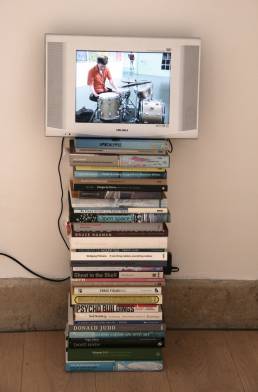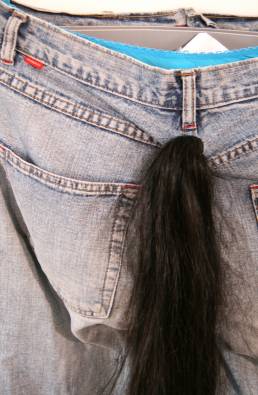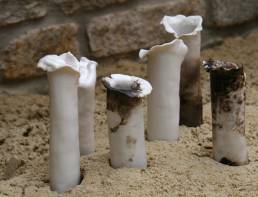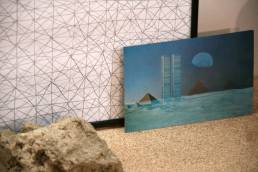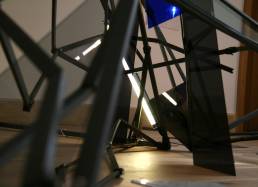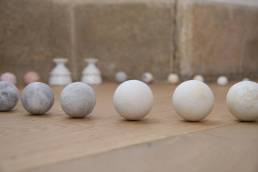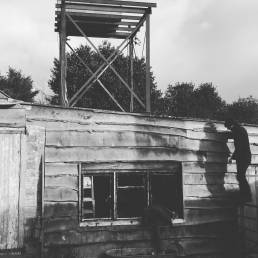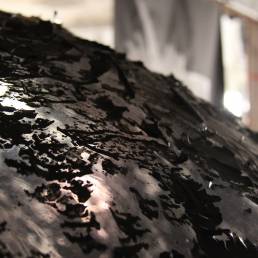Everything and More OSR Projects at the Old School Room.
15 – 30 September 2012.
Wednesday – Saturday 11am – 6pm – Sunday 12 – 4pm
Jethro Brice – Megan Calver – Simon Lee Dicker – Sue Palmer – Chantelle Henocq – Harry Lawson – Hannah Still – Gabriel Stones – Theo Wood
With a sense of detachment from the notion of the artist’s studio as romantic atelier, Everything and More presents a collision of ideas, images, objects, live work and creative detritus left behind by the latest incarnation of the transitional artist group OSR Projects.
Attempting to avoid autocracy, the curatorial structure initiated by Simon Lee Dicker began by inviting two artists to participate, who in turn invited others. Although this orderly ‘paper chain’ construction loosened and changed, the initial aspiration to encourage joint curatorial decision making through artist dialogue stayed true.
A blog ‘before everything’ was built as a vehicle for an exchange of ideas and information between the nine artists and the connections made informed the direction of the exhibition.
Everything & More, the antithesis of commercially-orientated open studios, seeks to avoid staging the process of making products, and instead revolves around the fragmented and transient processes of production which supports, and becomes, the artist’s practice. The exhibition includes work that looks at the ‘unresolved’ and ‘unfinished’ as the subject itself, and presents work in progress, failed work and the detritus that surrounds creative production. These works all respond to this notion of ‘in process’: the incomplete, the insurmountable, work that never quite worked out, buried at the back of a workspace for years, while others deliberately work with the unfinishable – work continually in flux.
The title of the exhibition is inspired by Alighiero e Boetti’s, Tutto (Everything), a series of embroideries dating from the late 1980s that “ … make a nonsense of the practice of discordant juxtaposition because they gather too many different kinds of images for any readings of particular juxtapositions to be tenable” 1
Individual works intertwine, repel and attract, creating a complex multifaceted installation that forces conversations between the component parts. The voice of the solitary author recedes, allowing connections to be made and facets of the creative process that usually remain hidden to be revealed.
1 Mark Godfrey ‘Alighiero e Boetti’ Yale University Press 2011 – p185
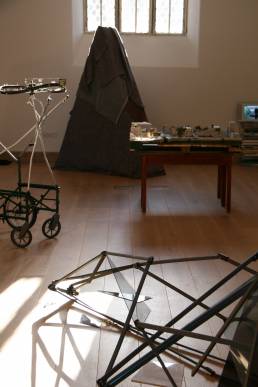
Gabriel Stones
I’m an artist living and working in London, currently studying at the Royal Academy.
I am interested in displacement as an artistic tool. I’ll use techniques like bootlegging or pastiche, nihilistic modes of representation, to drag ideas through psychologies both internal and external. Works often aspire to float free from the realm of objects or to exist in a parallel or underground world. The results are generally sculptural, though materials and processes are inconsistent.
Harry Lawson
I’m currently in the middle of an MA in Sculpture at The Royal College of Art
I think I see my work as a kind of archaeology of the present. Currently I’m researching the events of 9/11, which happened just over a decade ago now. Today almost everyone I know can recall exactly where they were that day. Last year I visited New York for the first time, and at one point ended up near The World Trade Centre site. I decided to take a look, almost as a token thing, without seriously thinking about what I was doing. There was pretty much nothing to see, just a huge barrier around Ground Zero where the 9/11 memorial and the new One World Trade Centre was being constructed. I hadn’t been directly involved in 9/11 and it felt disrespectful that I had arrived there the way I did. Later that day I couldn’t sleep, and started to re-watch some footage from 9/11. It’s still every bit as captivating now as it was then. The sheer scale of it is so overwhelming. No wonder the composer Stockhausen called it ‘The greatest work of art imaginable for the whole cosmos.’
Clearly the moral dilemma of researching 9/11 as an artist continues to worry me. The tension around this has made me tread incredibly cautiously around making artworks containing references to 9/11, particularly the imagery. My hope is to relax the viewer into rethinking what is happening to 9/11 as it passes into history, and how it is affecting the way we look and think through time.
Sue Palmer
Contemporary artist making live performance, sound, video and digital artworks, through collaborative work with people in relation to context and contemporary culture. Conversation, exchange, collaboration. Art as enquiry, place responsive, temporary communities. And what is produced might be a video, soundwork, text, a game, presentation, performance, a live event, a band, a collection.
Jethro Brice
Jethro Brice grew up in London and Jerusalem, studied at the Glasgow School of Art (BA(hons) Environmental Art, 2006) and has lived and worked in cities across the UK, Europe and the Middle East.
He works across media and fields of professional practice, encompassing drawing, sculpture, installation, public interventions, illustration, painting and design. His work is characterised by a love of anecdotic detail, a combination of sincerity and wry humour, an interest in human interactions with/in nature, and a conscious approach to the social and political aspects of art, production and life.
Theo Wood
Theo Wood lives and works in Bristol. Her art has a strong environmental element involving celebration and concern for the natural world. She works across disciplines using printmaking, photography, ceramics and text to explore projects and themes and produce works that can be shown both indoors and in the external environment.
Recently graduated from the University of the West of England with an MA in Multidisciplinary Printmaking (Distinction), she is a member of Spike Print Studio.
Megan Calver
Megan Calver originally studied English and American Literature. She made her first thin pencil lines on her thirty-eighth birthday in the sketchbook given to her by one of her two daughters. Since then she has made and thought about art, using any number of materials and methods to research an enquiry in hand. She thinks that a process-based practice such as hers requires both chance and self-restraint. It is a question of the balance between finding, giving up and creating what can be known.
Recent work includes quiet interruptions in public spaces and collaboration with Social Scientists at Bournemouth University on a project about memory loss.
